FIELD VETERINARY REPORT FOR MASAI MARA CONSERVATION AREA -JULY 2016
FIELD VETERINARY REPORT FOR MASAI MARA CONSERVATION AREA -JULY 2016.
By Dr. Campaign K.Limo
Introduction
The month was characterised by a drop in precipitation and an influx of wildebeest into Mara from Serengeti as the time coincides with their annual migration. There is also an increase of tourists to witness this spectacle. There is still plenty of food and water for the wildlife to utilise.
Follow-up on several cases handled the previous month including the injured rhino indicate they responded well and are now recovered.
The following are cases that were handled during the period under review;
CASE#1 ASSESSMENT OF AN ELEPHANT BULL
Date: 13th July 2016
Species: African elephant
Sex: Male
Age: Adult
Location: Olarro Conservancy (Siana)
History
This massive bull was seen by Olarro Conservancy rangers in company of two other equally big bulls within Siana area with a slight whitish discharge on his right flank. They reported to have seen him two days before with a small closed swelling on the same spot but feeding normally. They informed the mobile veterinary unit for assessment and advice on the way forward.
General observation:
This bull was found in the company of three other males browsing in a small thicket full of acacia trees.
All of them were feeding normally and in good body condition. Examination of this particular bull showed he had a small shallow abscess that had recently ruptured discharging all the pus out. At the time of arrival, the wound was dry with all the pus drained out. Nothing unusual in the behaviour and body condition of this bull was noticed. Closer examination revealed no foreign body lodged but just a normal abscess that ruptured.
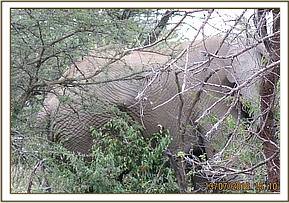

After weighing in the options, it was decided not necessary to immobilise this elephant as the condition did not warrant intervention. The elephant was in good shape and could heal without intervention. The Olarro management was advised to monitor this bull and report to the unit on his progress.
CASE#2 SNARED ZEBRA
Date: 13th July 2016
Species: Common zebra
Sex: Female
Age: Young adult
Location: Olarro Conservancy (Sianna area)
History
This zebra was spotted with a snare round his neck by Olarro and Sianna rangers on their routine patrols. They sought the services of the Mobile Veterinary Unit to de-snare this zebra.
This zebra was seen in company of wildebeests with no other zebras close to her. The other zebras were several hundred meters away from her. The wire could be seen dangling from her neck making her uncomfortable as she tried to graze. She appeared restless.
Immobilization, examination and de-snaring
Restraint was achieved chemically by use of a combination of 6mgs Etorphine hydrochloride and 50mgs Azaperone in a 1.5ml dan-inject dart fired from a vehicle. It took eight minutes for the drugs to take full effect with the zebra going down on her left lateral side. A plain wire snare round her neck was removed. It was not very tight but had created an abrasion wound round the neck. The wounds were disinfected with Iodine and Oxytetracycline spray applied. In addition, she received 3000mgs Amoxicillin antibiotic parenterally.


Reversal
The anaesthetic was reversed using intravenous administration of 18mgs Diprenorphine hydrochloride through the jugular vein. She woke up in three minutes and joined the wildebeests nearby.
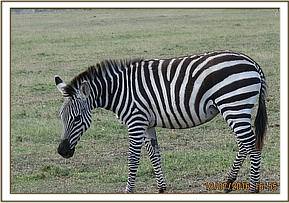
Prognosis
Good.
CASE#3 INJURED LION
Date: 18th July 2016
Species: African lion
Sex: Male
Age: sub adult
Location: Naboisho conservancy
History
This injured lion was first seen injured and reported for our attention by The Mara Lion Project team.
This lion was seen in the company of another male lion with an injury on his face lying under a small thicket. He seemed to be in pain and needed attention.
Immobilization, examination and treatment
This lion was chemically restrained by use of a combination of 4.8mgs Medetomidine and 230mgs Ketamine hydrochloride delivered in a 3ml Dan-inject dart fired from a vehicle. It took 15 minutes for the drugs to take full effect with the lion assuming sternal recumbency after retreating deeper into the thicket. After confirming that he was stable, he was stretchered out of the thicket into an open field for examination and treatment.
Examination revealed a deep wound on his face suspected to have been caused by a bite from other lions after a fight. The wound was deep and accessed the nasal cavity with mucoid discharge streaming from the wound opening. Treatment involved debriding the wound with dilute Hydrogen peroxide on a gauze swab to remove as much dead debris as possible, irrigation with tincture of iodine and infusion of cloxacillin ointment.


This lion further received 3000mgs Amoxicillin antibiotic and 20mgs Dexamethasone sodium anti-inflammatory all administered intramuscularly. To take care of both internal and external parasites, he was given 80mgs Ivermectin subcutaneously.
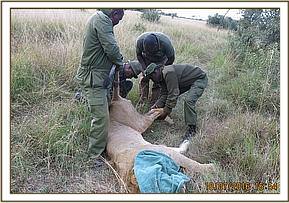

Reversal
The anaesthetic was reversed by intramuscular administration of 15mgs Atepamezole hydrochloride one hour after immobilization. He woke up after ten minutes and retreated back to the thicket.
Prognosis
Good
CASE#4 INJURED SUB ADULT LION
Date: 19th July 2016.
Species: African lion
Age: Sub adult
Sex: Male
Location: Olare Motorogi Conservancy
History
This young male was seen at the border of Olare Motorogi and Masai Mara National Reserve by The Mara Lion Project team alone with an injury on his back. They requested the services of the unit for assessment and possible treatment. The wound looked septic and needed attention.
Immobilization examination and treatment
Immobilization was achieved by use of a combination of 4mgs Medetomidine and 220mgs Ketamine hydrochloride in a 3ml dan-inject dart from a vehicle. It took 15 minutes for the drugs to take full effect with the lion assuming right lateral recumbency.


Examination revealed a deep bite wound on the lumbar section of his spine. Luckily the spinal cord was not affected. The wound was beginning to get septic and was most likely caused by conflicts with other lions. The wound was debrided with dilute Hydrogen peroxide, wiped clean with a swab and rinsed with clean water before tincture of iodine being applied.
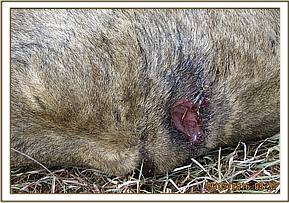
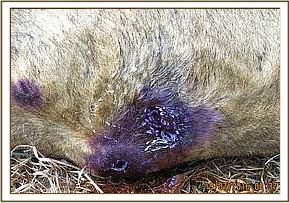

The wound was then infused with cloxacillin antibiotic ointment.
Additional treatments include intramuscular administration of 3000mgs Amoxicillin antibiotic and 20mgs Dexamethasone sodium anti-inflammatory. He was also given 80mgs Ivermectin parasiticide to take care of internal and external parasites.
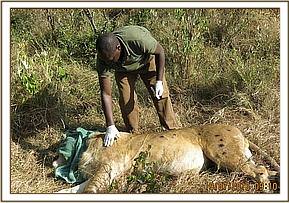
Reversal
The anaesthetic was reversed by intramuscular administration of 15mgs Atepamezole hydrochloride one hour after immobilization. He woke up after five minutes and walked away.
Prognosis
He is expected to make full recovery
CASE#5 INJURED ELEPHANT
Date: 21st July 2016
Species: African elephant
Sex: Female
Age: Adult
Location: BushTops area (Siana area)
History
This elephant was seen limping by the Bush Top scouts while on their patrols near their camp. They called the unit for assessment and treatment.
This elephant was found alone in a thicket browsing but with difficulty walking. She was limping on her right front limb.
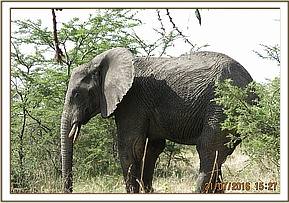

Immobilization examination and treatment
Immobilization was achieved by use of 15mgs Etorphine hydrochloride delivered in a 1.5ml Dan inject dart from foot because of the thicket. It took eight minutes for the drugs to take full effect with this elephant assuming left lateral recumbency. Examination revealed a penetrating wound to the inner side of her right front limb near the elbow. The wound was septic with purulent discharge and most likely caused by an arrow which had since fallen.
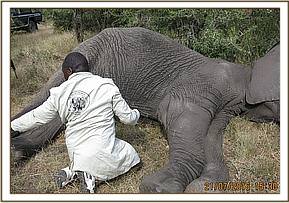

The pus was completely drained and wound cleaned with help of Hydrogen peroxide to remove all dead debris. Clean water was copiously used to rinse it before being disinfected with iodine and finally green clay being packed.
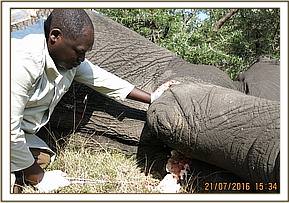

Additional treatment included parenteral administration of 30000mgs Amoxicillin antibiotic and 4000mgs Flunixin meglumine anti-inflammatory.
Reversal
The anaesthetic was reversed by 42mgs Diprenorphine hydrochloride given intravenously through a prominent ear vein. She woke up in three minutes and dashed back to the bush.
Prognosis
Good.
Other Activities
Other activities carried out during the Month include sampling of several wildlife ungulates for PPR which is a viral condition incriminated for losses of some small ruminants in pastoral areas within the country. Notable outbreaks with significant losses was reported in 2007 and 2008 where many small ruminants succumbed. Since then, there have been pockets of outbreaks in many parts of the country.
This sampling was done in collaboration with KWS headquarter team and the investigation will be done with Royal Veterinary College London and ministry of livestock. Similar sampling will be carried out by Ministry of livestock, veterinary department on domestic animals.
Samples from both domestic and wildlife species will be analysed for exposure or presence of the virus and will advise policy makers on way to prevent its circulation.
A total of 55 animals were sampled at livestock wildlife interface areas captured by darting and use of capture nets. Species sampled included, buffaloes, wildebeests, topis, hartebeest, grant gazelles, impalas, tommy gazelles, waterbucks and warthogs.
Acknowledgement
Mara Mobile Veterinary Unit would like to thank all partners who assisted during the month in one way or another towards response and treatment to the injured animals that required intervention.
Many thanks to Minara Foundation through DSWT for their continuous facilitation to the unit. Thanks to KWS management for their valuable guidance and advice to the unit. Without all your support it would be difficult to achieve all these.



















